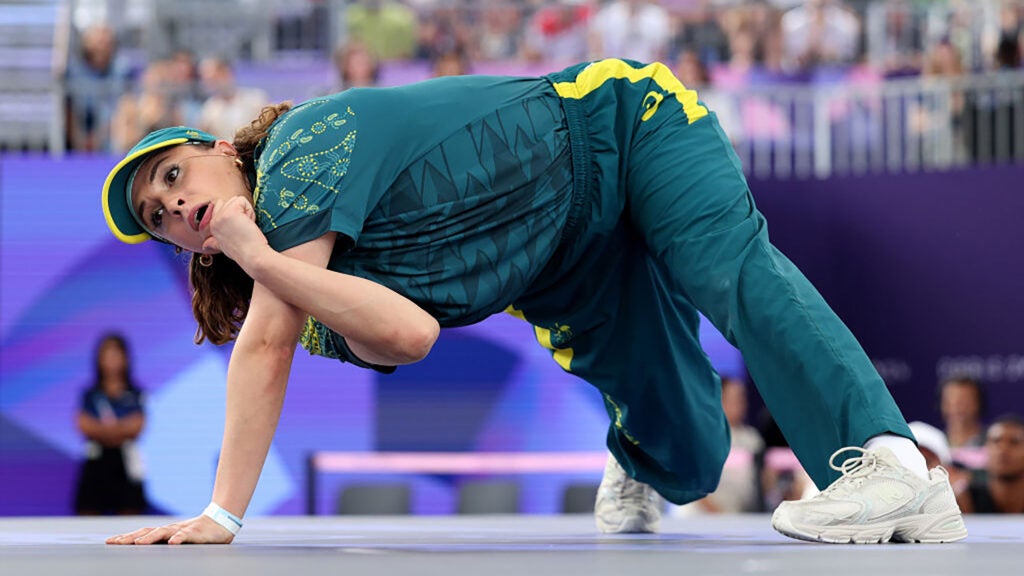No products in the cart.
Outdoor Adventure
Why Raygun Shouldn’t Have to Apologize for Her Olympic Breakdance
Don’t miss a moment of the 2024 Tour de France! Get recaps, insights, and exclusive takes with Velo’s daily newsletter.
Sign up today!.
A few days after the 2024 Summer Olympics in Paris wrapped up, I went to a restaurant with my family and noticed bizarre behavior from some of the patrons. A few tables away, a guy was hopping alongside his table with his hands curled in front of him like bunny paws as the other members of his party cracked up. At another table, a woman passed her phone around to her friends to show them a video. “Oh my god, what is she doing?” I heard one of them say.
The next morning, I saw more weirdness at my local swimming pool: kids and adults bounced off of the diving board and did mid-air kangaroo poses and breakdancing leg-grabs before splashing into the water.
Yep, this was the height of Raygun Mania, when the entire world seemed to be fixated on Australian Olympian Rachel Gunn, and her hilarious if cringe-worthy routine during Olympic breakdancing. Raygun’s marsupial-themed moves—yes, she called one of them the “Kangaroo hop”—earned zero points from the judges but became perhaps the singular moment of the entire Paris Games. If you spent any time on social media during the middle of August, you were probably inundated by a tidal wave of Raygun content: memes, spoofs, Big Lebowski mash-ups.
Dr Raygun is an Aussie legend.
We dance to our own beat.
And bring marsupial energy to every contest.
She’s a national treasure.
Give her an AO.
💚💛#Paris2024 pic.twitter.com/yaTaF5LTSz
— Craig Foster (@Craig_Foster) August 10, 2024
Even those who aren’t hyper-online were subject to it. British songstress Adele professed her love for Raygun to concertgoers. NBC Nightly News ran a segment about it. My 82-year-old Dad knew about Raygun and he’s never even been on Twitter.
These Raygun memes just keep going pic.twitter.com/1LaXD6yzip
— Dr. Scott Kelly (@drscottkelly) August 15, 2024
And then, like all modern media sensations, Raygun was fed into the wood chipper that is the American culture war, and a predictable process played out. There was the backlash (she’s a fraud!) and a backlash to the backlash (leave her alone!). Within a few days, the Internet became choked with mean-spirited hot takes attacking kangaroos, Australia, breakdancing, eighties pop culture, and anything else remotely connected to Raygun’s wackadoo antics. Meanwhile Gunn, 36, who is a university professor in Sydney, went into Internet hiding. And after a few days, the whole world moved on.
Well, this week Gunn broke her silence. In an exclusive interview with Australian TV show The Project, she defended her place on the Australian Olympic team. Gunn also apologized to Aussie B-Boys and B-Girls for all the negative vibes her antics attracted. “It is really sad to hear those criticisms and I am very sorry for the backlash that the community has experienced, but I can’t control how people react,” she said.
As someone who has covered niche sports and Olympic competition for the better part of the last two decades, I have my own take on the Raygun ordeal: She shouldn’t apologize for anything. In fact, everyone involved in competitive breakdancing and the Olympic movement should thank Gunn. Her 60-second dance routine cut through the global news cycle and attracted millions of eyeballs. By my estimation, Gunn sparked more conversations about breakdancing than every eighties film combined.
Grabbing this much awareness during the Olympics is tougher than you might assume. When I was a reporter with The SportsBusiness Journal, I regularly spoke to officials who worked in niche Olympic sports. They viewed the Summer Games as the single golden opportunity to showcase their sport to the masses.
Every four years, these officials strategize how to market their respective sports to casual viewers. They debate which athlete, or event, or highlight, will resonate with the American public. They know that a seminal Olympic moment will have a trickle-down effect that can attract new fans and participants.
Niche sports and the athletes who participate in them face a huge challenge at the Olympics, which our contributor Aimee Berg recently chronicled. In the U.S., swimming, women’s gymnastics, basketball, and track-and-field, dominate Olympics TV coverage, and star athletes like LeBron James and Katie Ledecky grab most of the attention. The best a niche athlete can hope for is a gold-medal performance, which may or may not lead to a three-minute segment during that night’s primetime TV coverage on NBC.
Sometimes gold medals aren’t enough to make an athlete a star. Velodrome cyclist Jennifer Valente now has three gold medals, a silver, and a bronze. But Valente can walk through any shopping mall in America without being noticed.
Raygun, meanwhile, upended this pecking order, and accomplished what all of those sports marketers could never do. She elevated her sport—which was new to the Olympic program, no less—to the top of the media frenzy at the Paris Games. In restaurants across the world, millions mimicked her dance and showcased her clips. They debated her merits and argued about her routine.
And of those millions, a not insignificant portion watched clips of other breakdancers. Maybe they saw the amazing moves of Canadian dancer Philip “Wizard” Kim, or watched Ami Yuasa of Japan defeat Dominika Banevic of Lithuania in the women’s final round. Perhaps some of these viewers showed those clips to their kids, who watched wide-eyed and wondered if they, too, could someday spin around on the ground to hip-hop music. And maybe some of those kids begged their parents to sign them up for a breakdancing class at the local recreation center or dancing academy.
Yes, Raygun’s dance was undeniably goofy. But what she accomplished for her sport was nearly impossible, and something that future sports marketers will try, and fail, to replicate. She shouldn’t be sorry for that.

